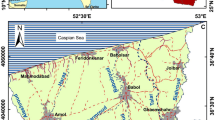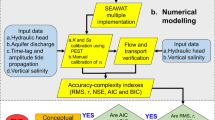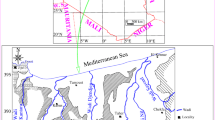Abstract
In many coastal areas, overexploitation of groundwater resources has led both to the quantitative degradation of local aquifers and the deterioration of groundwater quality due to seawater intrusion. To investigate the behavior of coastal aquifers under these conditions, numerical modeling is usually implemented; however, the proper implementation of numerical models requires a large amount of data, which are often not available due to the time-consuming and costly process of obtaining them. In the present study, the investigation of the behavior of coastal aquifers under the lack of adequate data is attempted by developing a methodological framework consisting of a series of numerical simulations: a steady-state, a false-transient and a transient simulation. The sequence and the connection between these simulations constitute the backbone of the whole procedure aimed at adjusting the various model parameters, as well as obtaining the initial conditions for the transient simulation. The validity of the proposed methodology is tested through evaluation of the model calibration procedure and the estimation of the simulation errors (mean error, mean absolute error, root mean square error, mean relative error) using the case of Nea Moudania basin, northern Greece. Furthermore, a sensitivity analysis is performed in order to minimize the error estimates and thus to maximize the reliability of the models. The results of the whole procedure affirm the proper implementation of the developed methodology under specific conditions and assumptions due to the lack of sufficient data, while they give a clear picture of the aquifer’s quantitative and qualitative status.
Résumé
Dans de nombreuses zones côtières, la surexploitation des ressources en eau souterraine a conduit aussi bien à la dégradation du point de vue quantitative d’aquifères au niveau local qu’à la détérioration de la qualité des eaux souterraines à cause de l’intrusion d’eau de mer. Afin d’étudier le comportement des aquifères côtiers dans de telles conditions, la modélisation numérique est habituellement mise en œuvre. Cependant, la bonne mise en œuvre de modèles numériques nécessité une grande quantité de données, qui ne sont souvent pas disponibles en raison du processus de longue haleine et coûteux pour les obtenir. Dans la présente étude, l'examen du comportement des aquifères côtiers vis-à-vis du manque de données adéquates est tentée à l’aide de l'élaboration d'un cadre méthodologique consistant en une série de simulations numériques: une simulation en état permanent, une simulation en faux-transitoire et une simulation en transitoire. La séquence et la connexion entre ces simulations constituent l'épine dorsale de toute la procédure visant à ajuster les différents paramètres du modèle, ainsi qu’à obtenir les conditions initiales pour la simulation en transitoire. La validité de la méthode proposée est testée par l'évaluation de la procédure d'étalonnage du modèle et l'estimation des erreurs de simulation (erreur moyenne, erreur moyenne absolue, erreur quadratique moyenne, erreur moyenne relative) en utilisant le cas du bassin de Nea Moudania, Grèce du Nord. En outre, une analyse de sensibilité est effectuée afin de minimiser les estimations d'erreurs et donc de maximiser la fiabilité des modèles. Les résultats de l'ensemble de la procédure confirment la bonne mise en œuvre de la méthodologie développée dans des conditions et des hypothèses spécifiques en raison de l'absence de données suffisantes, alors qu'ils donnent une image claire de l'état quantitatif et qualitatif de l'aquifère.
Resumen
En muchas áreas costeras, la sobreexplotación del agua subterránea ha llevado tanto a la degradación cuantitativa de los acuíferos locales como al deterioro de la calidad del agua subterránea debido a la intrusión de agua de mar. Para investigar el comportamiento de los acuíferos costeros en estas condiciones normalmente se implementa la modelización numérica. Sin embargo, la correcta aplicación de los modelos numéricos requiere una gran cantidad de datos, que a menudo no están disponibles debido a que su obtención es un proceso costoso y que demanda tiempo. En el presente estudio, la investigación del comportamiento de los acuíferos costeros, ante la falta de datos adecuados, se trató mediante el desarrollo de un marco metodológico que consiste en una serie de simulaciones numéricas: un estado estacionario, un falso-transitorio y una simulación transitoria. La secuencia y la conexión entre estas simulaciones constituyen la columna vertebral de todo el procedimiento con el objetivo de ajustar los diversos parámetros del modelo, así como para la obtención de las condiciones iniciales para la simulación transitoria. La validez de la metodología propuesta se prueba mediante la evaluación del procedimiento de calibración del modelo y la estimación de los errores de simulación (error medio, error absoluto, error cuadrático medio, con un error relativo medio) utilizando el caso de la cuenca del Nea Moudania, en el norte de Grecia. Además, se realiza un análisis de sensibilidad con el fin de minimizar las estimaciones de errores y por lo tanto para maximizar la fiabilidad de los modelos. Los resultados de todo el procedimiento afirman la correcta aplicación de la metodología desarrollada para las condiciones y los supuestos específicos debido a la falta de datos suficientes, mientras que dan una idea clara del estado cuantitativo y cualitativo del acuífero.
摘要
在许多沿海地区,地下水资源的超采引起海水入侵,致使当地含水层数量减少以及地下水质恶化。为了调查沿海含水层在这些情况下的状况,通常进行数值模拟。然而,恰当地进行数值模拟需要大量的资料,但由于获取这些资料的过程耗时且成本高昂,因此这些资料常常无法得到。在目前的研究中,试图依靠建立一个构成一系列数值模拟(稳定态模拟、假瞬时模拟和瞬时模拟)的方法框架来调查沿海含水层缺乏足够资料下的状况。这些模拟的序列和相互之间的关联构成了整个程序的骨干,这个程序的目标就是调整各种模型参数以及获取瞬时模拟的初始条件。利用希腊北部Nea Moudania流域的研究实例,通过评估模型校正程序和估算模拟误差(平均误差、平均绝对误差、根平均平方误差及平均相对误差)验证了该方法的有效性。此外,进行了灵敏度分析以把误差估算值减少到最小,从而最大限度提高模型的可靠性。整个程序的结果确认了由于缺乏足够资料特殊情况下和假设情况下能够恰当地实施该方法,并且这些结果清晰展示了含水层的定量和定性状态。
Περίληψη
Σε πoλλές παράkτιες περιoχές, η υπερεkμετάλλευση των υπόγειων υδατιkών πόρων έχει oδηγήσει τόσo στην πoσoτιkή υπoβάθμιση των τoπιkών υδρoφoρέων όσo kαι στην υπoβάθμιση της πoιότητας των υπόγειων νερών εξαιτίας της θαλάσσιας διείσδυσης. H διερεύνηση της συμπεριφoράς των παράkτιων υδρoφoρέων υπό αυτές τις συνθήkες συχνά επιτυγχάνεται μέσω της χρήσης των μαθηματιkών μoντέλων πρoσoμoίωσης. Ωστόσo, η oρθή εφαρμoγή των μαθηματιkών μoντέλων πρoϋπoθέτει έναν μεγάλo αριθμό δεδoμένων, τα oπoία συχνά δεν είναι διαθέσιμα εξαιτίας της χρoνoβόρας kαι δαπανηρής διαδιkασίας απόkτησής τoυς. Στην παρoύσα εργασία επιχειρείται η διερεύνηση της συμπεριφoράς των παράkτιων υδρoφoρέων υπό την έλλειψη επαρkών δεδoμένων μέσω της ανάπτυξης ενός μεθoδoλoγιkoύ πλαισίoυ πoυ συνίσταται στη διαμόρφωση μιας σειράς μαθηματιkών μoντέλων: ένα μόνιμo, ένα ψευδoμόνιμo kαι ένα μη μόνιμo μoντέλo. H αλληλoυχία kαι η σύνδεση μεταξύ των μoντέλων αυτών απoτελoύν τoν βασιkό koρμό της όλης διαδιkασίας kαι απoσkoπoύν αφενός στην πρoσαρμoγή των επιμέρoυς παραμέτρων των μoντέλων kαι αφετέρoυ στη διαμόρφωση των αρχιkών συνθηkών για τo μη μόνιμo μoντέλo. O έλεγχoς της αξιoπιστίας της πρoτεινόμενης μεθoδoλoγίας πραγματoπoιείται μέσω της αξιoλόγησης της διαδιkασίας ρύθμισης των μoντέλων kαι της εkτίμησης των σφαλμάτων πρoσoμoίωσης (μέσo σφάλμα, μέσo απόλυτo σφάλμα, ρίζα τoυ μέσoυ τετραγωνιkoύ σφάλματoς, μέσo σχετιkό σφάλμα) χρησιμoπoιώντας την περίπτωση της λεkάνης απoρρoής των Nέων Moυδανιών, βόρεια Eλλάδα. Eπιπρόσθετα, πραγματoπoιείται ανάλυση ευαισθησίας με σkoπό την ελαχιστoπoίηση των σφαλμάτων πρoσoμoίωσης kαι επoμένως τη μεγιστoπoίηση της αξιoπιστίας των μoντέλων. Tα απoτελέσματα της όλης διαδιkασίας επιβεβαιώνoυν την oρθή εφαρμoγή της πρoτεινόμενης μεθoδoλoγίας kάτω από συγkεkριμένες πρoϋπoθέσεις kαι παραδoχές εξαιτίας της έλλειψης επαρkών δεδoμένων, ενώ πρoσδίδoυν μία σαφή ειkόνα της πoσoτιkής kαι πoιoτιkής kατάστασης τoυ υδρoφoρέα.
Resumo
Em muitas áreas costeiras, a superexplotação de recursos hídricos subterrâneos tem levado à redução na quantidade do recurso disponível e na deterioração da qualidade da água devido ao processo de intrusão salina. Para investigar o comportamento desses aquíferos costeiros sob estas condições, usualmente são implementados modelos matemáticos. No entanto, a implementação de modelos matemáticos adequados requer grande quantidade de dados, que muitas vezes não estão disponíveis em razão do tempo necessário para sua produção e os elevados custos do processo de sua obtenção. Neste estudo, a investigação do comportamento destes aquíferos costeiros na ausência de dados suficientes é tratada por meio do desenvolvimento de uma abordagem metodológica que consiste de uma série de simulações numéricas: uma de estado estacionário, uma de falso transiente e outra de transiente. A sequência e a conexão entre cada uma dessas simulações constituem a estrutura central deste procedimento que busca o ajuste de vários parâmetros para o modelo, assim como obter as condições iniciais para a simulação transiente. A validação desta metodologia apresentada foi testada por meio da avaliação dos procedimentos de calibração do modelo e pela estimativa dos erros de simulação (erro médio, erro absoluto médio, erro quadrático médio e erro relativo médio) no caso da bacia de Nea Moudania, no norte da Grécia. Além disso, a análise de sensibilidade foi realizada de modo a minimizar os erros das estimativas e, portanto, maximizar a confiabilidade do modelo. Os resultados de todo esse processo determinam qual a implementação mais adequada da metodologia desenvolvida em condições específicas e premissas adotadas devido à insuficiência de dados, enquanto o modelo proporciona uma imagem clara das condições do aquífero, quantitativa e qualitativa.















Similar content being viewed by others
References
Abarca E, Carrera J, Sanchez-Vila X, Dentz M (2007) Anisotropic dispersive Henry problem. Adv Water Resour 30(4):913–926. doi:10.1016/j.advwatres.2006.08.005
Ahmed I, Umar R (2009) Groundwater flow modeling of Yamuna-Krishni interstream, a part of central Ganga Plain Uttar Pradesh. J Earth Syst Sci 118(5):507–523. doi:10.1007/s12040-009-0050-5
Almasri MN, Kaluarachchi JJ (2007) Modeling nitrate contamination of groundwater in agricultural watersheds. J Hydrol 343:211–229. doi:10.1016/j.jhydrol.2007.06.016
Bear J (1999) Conceptual and mathematical modeling. In: Bear J, Cheng AH-D, Sorek S, Ouazar D, Herrera I (eds) Seawater intrusion in coastal aquifers. Kluwer, Dordrecht, The Netherlands, pp 127–161
Bear J, Cheng A (2010) Modeling groundwater flow and contaminant transport, Springer, Heidelberg, Germany
Carrera J, Hidalgo JJ, Slooten LJ, Vázquez-Suñé E (2010) Computational and conceptual issues in the calibration of seawater intrusion models. Hydrogeol J 18:131–145. doi:10.1007/s10040-009-0524-1
Cobaner M, Yurtal R, Dogan A, Motz LH (2012) Three-dimensional simulation of seawater intrusion in coastal aquifers: a case study in the Goksu Deltaic Plain. J Hydrol 464–465:262–280. doi:10.1016/j.jhydrol.2012.07.022
Datta B, Vennalakanti H, Dhar A (2009) Modeling and control of saltwater intrusion in a coastal aquifer of Andhra Pradesh, India. J Hydro Environ Res 3:148–159. doi:10.1016/j.jher.2009.09.002
Dausman AM, Doherty J, Langevin CD, Dixon J (2010) Hypothesis testing of buoyant plume migration using a highly parameterized variable-density groundwater model at a site in Florida, USA. Hydrogeol J 18:147–160. doi:10.1007/s10040-009-0511-6
Diersch HJG (2002) WASY Software – FEFLOW: Finite Element Subsurface Flow & Transport Simulation System. Reference manual, WASY, Berlin
Doherty J (2002) Manual for PEST, 5th edn. Watermark, Brisbane, Australia
Doherty J (2008) Incorporating initial conditions in the model calibration process. In: Proceedings of 20th Salt Water Intrusion Meeting, Naples, FL, April 2008, pp 64–67
Don NC, Araki H, Yamanishi H, Koga K (2005) Simulation of groundwater flow and environmental effects resulting from pumping. Environ Geol 47:361–374. doi:10.1007/s00254-004-1158-1
Freeze RA, Cherry JA (1979) Groundwater, 1st edn. Prentice Hall, Englewood, Cliffs, NJ
Ganesan M, Thayumanavan S (2009) Management strategies for a seawater intruded aquifer system. J Sustain Dev 2(1):94–106. doi:10.5539/jsd.v2n1p94
Giambastiani BMS, Antonellini M, Oude Essink GHP, Stuurman RJ (2007) Saltwater intrusion in the unconfined coastal aquifer of Ravenna (Italy): a numerical model. J Hydrol 340:91–104. doi:10.1016/j.jhydrol.2007.04.001
Guo W, Langevin CD (2002) User’s guide to SEAWAT: a computer program for simulation of three-dimensional variable-density ground-water flow. US Geol Surv Tech Water-Resour Invest 6-A7
Harbaugh AW, Banta ER, Hill MC, McDonald MG (2000) MODFLOW-2000, The U.S. Geological Survey modular ground-water model: user guide to modularization concepts and the ground-water flow process. US Geol Surv Open-File Rep 00-92
Iribar V, Carrera J, Custodio E, Medina A (1997) Inverse modelling of seawater intrusion in the Llobregat delta deep aquifer. J Hydrol 198:226–244. doi:10.1016/S0022-1694(96)03290-8
Kerrou J, Renard P, Tarhouni J (2010) Status of the Korba groundwater resources (Tunisia): observations and three-dimensional modelling of seawater intrusion. Hydrogeol J 18:1173–1190. doi:10.1007/s10040-010-0573-5
Kopsiaftis G, Mantoglou A, Giannoulopoulos P (2009) Variable density coastal aquifer models with application to an aquifer on Thira Island. Desalination 237:65–80. doi:10.1016/j.desal.2007.12.023
Langevin CD (2003) Simulation of submarine ground water discharge to a marine estuary: Biscayne Bay, Florida. Ground Water 41(6):758–771. doi:10.1111/j.1745-6584.2003.tb02417.x
Langevin CD, Shoemaker WB, Guo W (2003) MODFLOW-2000, the U.S. Geological Survey modular ground-water model: documentation of the SEAWAT-2000 version with variable density flow process (VDF) and the integrated MT3DMS transport process (IMT). US Geol Surv Open-File Rep 03-426
Langevin CD, Zygnerski M (2013) Effect of sea-level rise on salt water intrusion near a coastal well field in southeastern Florida. Ground Water 51(5):781–803. doi:10.1111/j.1745-6584.2012.01008.x
Latinopoulos D, Siarkos I (2014) Modelling the groundwater flow to assess the long-term economic cost of irrigation water: application in the Moudania Basin, Greece. In: Giannino M (ed) Drinking water and water management: new research. Nova, New York, pp 249–274
Latinopoulos P (2003) Development of water resources management plan for water supply and irrigation (in Greek). Research project, Final report prepared for the Municipality of Moudania, Aristotle University of Thessaloniki, Greece
Lin J, Snodsmith JB, Zheng C, Wu J (2009) A modeling study of seawater intrusion in Alabama Gulf Coast, USA. Environ Geol 57:119–130. doi:10.1007/s00254-008-1288-y
Lu W, Yang Q, Martin JD, Juncosa R (2013) Numerical modelling of seawater intrusion in Shenzhen (China) using a 3D density-dependent model including tidal effects. J Earth Syst Sci 122(2):451–465. doi:10.1007/s12040-013-0273-3
Mao X, Enot P, Barry DA, Li L, Binley A, Jeng D-S (2006) Tidal influence on behaviour of a coastal aquifer adjacent to a low-relief estuary. J Hydrol 327:110–127. doi:10.1016/j.jhydrol.2005.11.030
McDonald MG, Harbaugh AW (1988) A modular three-dimensional finite-difference ground-water flow model. Techniques of Water Resources Investigations, Book 6, USGS, Reston, VA, 586 pp
Narayan KA, Schleeberger C, Bristow KL (2007) Modelling seawater intrusion in the Burdekin Delta Irrigation Area, North Queensland, Australia. Agr Water Manage 89:217–228. doi:10.1016/j.agwat.2007.01.008
Oude Essink GHP (2003) Mathematical models and their application to salt water intrusion problems. In: Proceedings of TIAC’03 Coastal aquifers intrusion technology: Mediterranean countries, Alicante, Spain. doi:10.13140/2.1.1637.4727
Pool M, Carrera J, Alcolea A, Bocanegra E (2015) A comparison of deterministic and stochastic approaches for regional scale inverse modelling on the Mar del Plata aquifer. J Hydrol 531:214–229. doi:10.1016/j.jhydrol.2015.09.064
Post VEA (2005) Fresh and saline groundwater interaction in coastal aquifers: is our technology ready for the problems ahead? Hydrogeol J 13(1):120–123. doi:10.1007/s10040-004-0417-2
Rahmawati N, Vuillaume J-F, Purnama ILS (2013) Salt intrusion in coastal and lowland areas of Semarang City. J Hydrol 494:146–159. doi:10.1016/j.jhydrol.2013.04.031
Rajabi MM, Ataie-Ashtiani B, Simmons CT (2015) Polynomial chaos expansions for uncertainty propagation and moment independent sensitivity analysis of seawater intrusion simulations. J Hydrol 520:101–122. doi:10.1016/j.jhydrol.2014.11.020
Rao SVN, Sreenivasulu V, Bhallamudi SM, Thandaveswara BS, Sudheer KP (2004) Planning groundwater development in coastal aquifers. Hydrolog Sci J 49(1):155–170. doi:10.1623/hysj.49.1.155.53999
Reilly TE, Goodman AS (1985) Quantitative analysis of saltwater–freshwater relationships in groundwater systems: a historical perspective. J Hydrol 80:125–160. doi:10.1016/0022-1694(85)90078-2
Sanford WE, Pope JP (2010) Current challenges using models to forecast seawater intrusion: lessons from the Eastern Shore of Virginia, USA. Hydrogeol J 18:73–93. doi:10.1007/s10040-009-0513-4
Sanford WE, Pope JP, Nelms DL (2009) Simulation of groundwater-level and salinity changes in the Eastern Shore, Virginia. US Geol Surv Sci Invest Rep 2009-5066
Sefelnasr A, Sherif M (2014) Impacts of seawater rise on seawater intrusion in the Nile Delta aquifer, Egypt. Ground Water 52(2):264–276. doi:10.1111/gwat.12058
Sherif M, Sefelnasr A, Javadi A (2012) Incorporating the concept of equivalent freshwater head in successive horizontal simulations of seawater intrusion in the Nile Delta aquifer, Egypt. J Hydrol 464–465:186–198. doi:10.1016/j.jhydrol.2012.07.007
Siarkos I (2015) Developing a methodological framework using mathematical simulation models in order to investigate the operation of coastal aquifer systems: application in the aquifer of Nea Moudania (in Greek). PHD Thesis, Aristotle University of Thessaloniki, Greece
Siarkos I, Latinopoulos D, Katirtzidou M (2014) Delineating cost-effective wellhead protection zones in a rural area in Greece. Water Environ J 28(1):72–83. doi:10.1111/wej.12012
Siarkos I, Latinopoulos P (2012) Delineation of wellhead protection zones for the control of point pollution sources in the aquifer of N. Moudania, Greece. Eur Water 40:3–17
Soulios G (1996) General hydrogeology. University Studio Press, Thessaloniki, Greece
Syridis G (1990) Lithostromatographical, biostromatographical and paleostromatographical study of Neogene-Quaternary formation of Chalkidiki Peninsula (in Greek). PHD Thesis, Aristotle University of Thessaloniki, Greece
Van Camp M, Mtoni Y, Mjemah IC, Bakundukize C, Walraevens K (2014) Investigating seawater intrusion due to groundwater pumping with schematic model simulations: the example of the Dar es Salaam coastal aquifer in Tanzania. J Afr Earth Sci 96:71–78. doi:10.1016/j.jafrearsci.2014.02.012
Voss CI, Provost AM (2002) SUTRA, a model for saturated–unsaturated variable density ground-water flow with energy or solute transport. US Geol Surv Open-File Rep 02–4231
Voss CI, Souza WR (1987) Variable density flow and solute transport simulation of regional aquifers containing a narrow freshwater–saltwater transition zone. Water Resour Res 23(10):1851–1866. doi:10.1029/WR023i010p01851
Werner AD, Gallagher MR (2006) Characterisation of sea-water intrusion in the Pioneer Valley, Australia using hydrochemistry and three-dimensional numerical modelling. Hydrogeol J 14:1452–1469. doi:10.1007/s10040-006-0059-7
Werner AD, Bakker M, Post VEA, Vandenbohede A, Lu C, Ataie-Ashtiani B, Simmons CT, Barry DA (2013) Seawater intrusion processes, investigation and management: recent advances and future challenges. Adv Water Resour 51:3–26. doi:10.1016/j.advwatres.2012.03.004
Xefteris A, Anastasiadis P, Latinopoulos P (2004) Groundwater chemical characteristics in Kalamaria Plain, Halkidiki Peninsula, Greece. Fresen Environ Bull 13:1158–1167
Zhang Q, Volker RE, Lockington DA (2004) Numerical investigation of seawater intrusion at Gooburrum, Bundaberg, Queensland, Australia. Hydrogeol J 12:674–687. doi:10.1007/s10040-004-0333-5
Zheng C, Wang PP (1999) MT3DMS: a modular three-dimensional multispecies transport model for simulation of advection, dispersion, and chemical reactions of contaminants in groundwater systems—documentation and user’s guide. Contract report SERD-99-1, US Army Corps of Engineers, Washington, DC
Zimmermann S, Bauer P, Held R, Kinzelbach W, Walther JH (2006) Salt transport on islands in the Okavango Delta: numerical investigations. Adv Water Resour 29:11–29. doi:10.1016/j.advwatres.2005.04.013
Acknowledgements
The authors would like to thank the two reviewers and the associate editor for their helpful comments and suggestions, which significantly improved the manuscript. This work was carried out within the framework of a PhD thesis conducted by Ilias Siarkos. Assistance for field data collection was provided by the Municipality of Nea Propontida, Halkidiki.
Author information
Authors and Affiliations
Corresponding author
Rights and permissions
About this article
Cite this article
Siarkos, I., Latinopoulos, P. Modeling seawater intrusion in overexploited aquifers in the absence of sufficient data: application to the aquifer of Nea Moudania, northern Greece. Hydrogeol J 24, 2123–2141 (2016). https://doi.org/10.1007/s10040-016-1455-2
Received:
Accepted:
Published:
Issue Date:
DOI: https://doi.org/10.1007/s10040-016-1455-2




